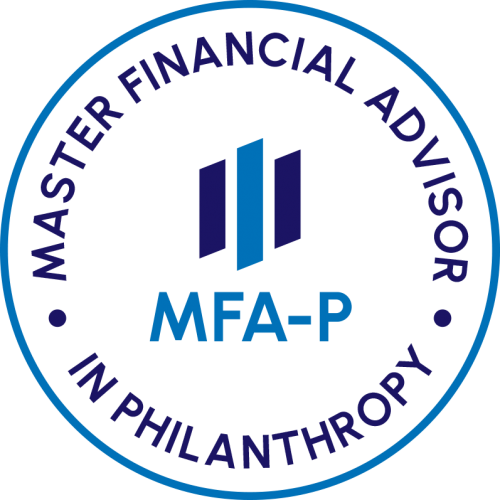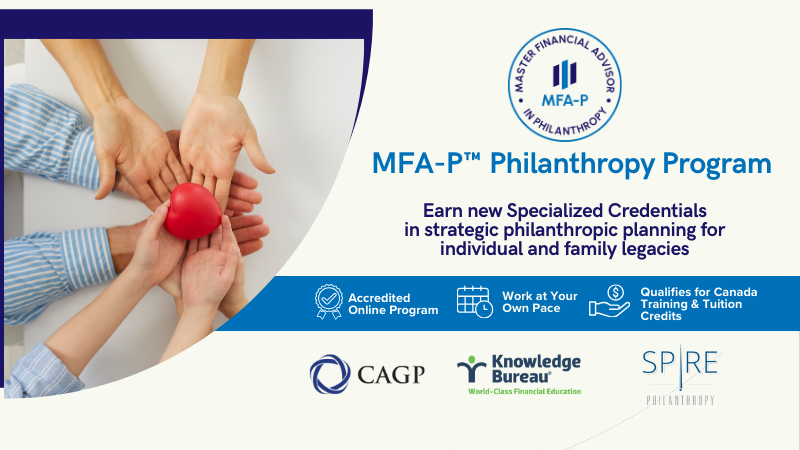Last updated: June 25 2025
The Shifting Landscape of Philanthropy in Canada

Geoff Currier
Charitable giving has changed noticeably in recent years. As professionals who prepare tax returns or provide estate and legacy planning services, you will almost certainly have noticed a decline in the number of clients who are giving. But donors who plan strategically throughout the year may be more inclined to give more and most important, highly value the opportunity to discuss this with a training strategist. This is where the MFA-P™ designation program comes in. Consider the following as a key professional opportunity:
Fewer Donors Every Year: According to canadahelps.org, fewer Canadians donated to a charity for the 11th straight year in 2024. This trend runs counter to the increased demand for services, particularly since the pandemic. Approximately one in five Canadians makes use of a charity to meet their needs.
The Big Donors Step Up: There’s charitable giving and then there’s philanthropy, which aren’t always the same. Philanthropy is defined as the desire to promote the welfare of others,  expressed especially by the generous donation of money to good causes.
expressed especially by the generous donation of money to good causes.
Canadian Families Offices reported recently that less than one percent of individual donors are responsible for 38 per cent of all charitable giving. Those numbers are from 2022. This aligns with the traditional definition of philanthropy which we typically associate with the more affluent.
According to Madeinca.ca, there are some 86,000 registered charities in Canada. You have probably noted that the most likely people to donate to charities or non profit organizations are those 65 and older. In 2021, for which the Madeinca.ca stats are available, Ontarians gave the largest amount at over $5 billion but Manitobans are the most likely to make a donation. Manitobans pride themselves on being the most generous people in Canada and the stats back them up.
There are some numbers which run contrary to each other. As mentioned, it will not surprise you as tax professionals that the number of Canadians donating to charities dropped by 2% between 2016 and 2020. The actual dollar amount over that same period jumped an impressive 19%. What we are seeing is a decline in donations from the average wage earner and an increase in donations from foundations, corporations and wealthy Canadians.
This from Statistics Canada: https://www150.statcan.gc.ca/n1/daily-quotidien/250401/dq250401c-eng.htm
“In 2023, there were just over 5 million (+1.9%) tax filers who reported a total of $12.8 billion in charitable donations, a $1.4 billion (+11.8%) increase over 2022. In addition, the median donation increased by 2.6% during this period to $390.”
More Attention Needs to be Paid: It probably didn’t come up in conversation at the recent G7 meeting but it’s interesting to note that Canada is the only G7 country without a research facility devoted to the study of philanthropy. There are some people at Carleton University in Ottawa who are working on developing one.
The Tax Benefits: Even if your clients aren’t in a position to make large donations to a charity, they can still reap the tax benefits, and you can help guide them through the ways giving to a charity can help reduce their taxes payable. Many of your clients may be surprised at the ways they can reduce their taxable income. Even a donation of $199 can result in a $30 refund. If the donation is over $200, the tax credit is 29% of the donation. This can be a significant reduction in tax payable.
Canadahelps.org is a resource which might be useful to your clients. This website provides good information. There’s a huge variance when it comes to provincial tax credits. They can range from 20% to 75%, depending on where your clients live. It’s important that you help them understand the benefits they can claim. There are other avenues as well, including avoiding tax on capital gains by donating appreciated stocks, stock options or mutual funds. There’s flexibility here too. Your clients could save their charitable tax credits for future returns of up to five years.
Supporting Philanthropic Leadership Through Education:
For tax and financial advisors who want to better guide clients in making meaningful and tax-effective charitable contributions, advanced training is available through the MFA-P™ Philanthropy program. This specialized designation equips professionals with the expertise to align charitable intentions with strategic financial planning. It’s an essential credential in today’s philanthropic environment—where fewer donors are giving more—empowering advisors to lead important conversations about legacy, impact, and tax efficiency. Learn more about how you can help your clients become more effective philanthropists while building your own professional credentials. Check out our annual tuition reduction offer until June 30 and register now online!
The Bottom Line: By directing your clients to the websites listed in this article they will gain a better understanding of the tax advantages of charitable giving. They will be that much wiser come tax time next year when they bring their receipts to you. You can never remind your clients too often of the importance of maintaining accurate records and keeping all appropriate receipts.
Not only will your clients who give be helping charitable organizations, they’ll be making Canada a better place.
Stay tuned weekly to Knowledge Bureau Report for continuing coverage of breaking tax and economic news and tune in to a new podcast- Real Tax News You Can Use with Evelyn Jacks
